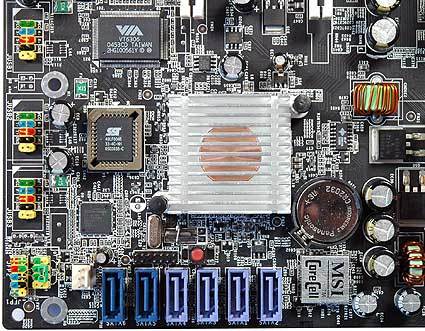Budget And Premium Motherboards At The Crossroads
Mass Storage Controllers
While the nForce4 Intel Edition chipset supports four Serial ATA II drives as well as four UltraATA/133 devices, MSI decided to add another Silicon Image chip enabling two more SATA ports.
It usually takes a little while for chipset makers to introduce the latest storage interface standards into their products. For this reason, motherboard makers keep implanting additional storage controllers onto their upper class motherboards. When Serial ATA was first introduced, for example, suppliers such as HighPoint, Promise and Silicon Image were offering add-on cards or single controller chips well before Intel, SiS, VIA and others integrated SATA into their core logic.
Yet there is another reason for adding additional mass storage controllers: Some chipsets do not feature enough legacy interfaces for attaching all the drives an enthusiast user may still need to use. Intel's 900 chipset family is a good example; The ICH6/ICH7 series south bridge only has one UltraATA/100 port that allows two drives. Many users already have two optical drives, such as a fast DVD ROM and a DVD burner, and would be forced to abandon any UltraATA hard drives they may still want to use.
Network Connectivity
MSI placed two PCI Express Gigabit Ethernet controllers from Marvell onto the P4N Diamond.
Network controllers traditionally were installed by plugging in a network adapter card into an expansion slot. The first models ran 10BASE2 or 10 Mbit Ethernet networks via ISA, while following generations switched to 100 Mbit/s and the PCI bus. Broadband Internet access and the widespread adoption of local networks made network adapters a prerequisite for everyday computers. Accordingly, about six years ago, the move began to integrate these components directly onto motherboards; this was an important step to reducing overall costs for computers with network connectivity.
As Ethernet continued to evolve, the PCI bus became a bottleneck itself. Intel introduced the CSA interface (Communication Streaming Architecture) with the release of their 865 and 875 chipsets, allowing a dedicated Gigabit Ethernet controller to be attached directly to the chipset north bridge. All preceding solutions required network adapters to be attached to the south bridge, with network traffic burdening the path between the chipset parts.
The introduction of PCI Express finally caused Intel to drop CSA, since the serial architecture offers enough bandwidth for Gigabit Ethernet applications. Most high-end motherboards even come with two Gigabit Ethernet ports these days. This allows the system to be used as a software-based router and/or firewall between two networks, either to connect two local networks or to link a LAN to the Internet.
Get Tom's Hardware's best news and in-depth reviews, straight to your inbox.

Patrick Schmid was the editor-in-chief for Tom's Hardware from 2005 to 2006. He wrote numerous articles on a wide range of hardware topics, including storage, CPUs, and system builds.

